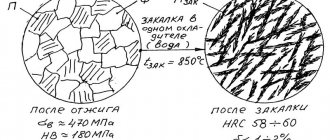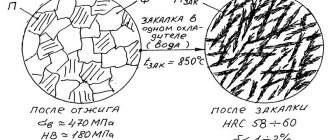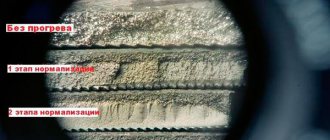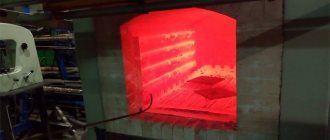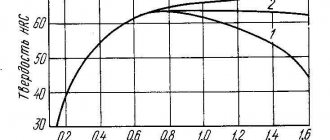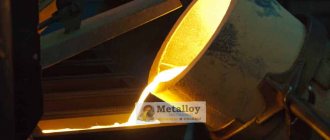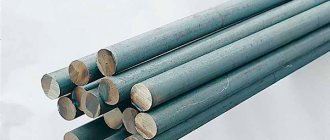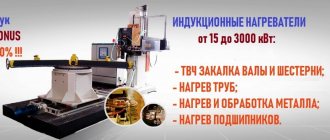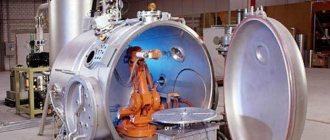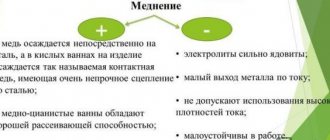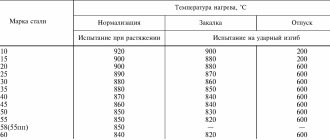Steel after hardening: structure and properties
Steel in its usual form is a fairly soft and malleable metal.
Some grades do not require special strength (these are the so-called ordinary quality steels, produced in accordance with the requirements of GOST 380): the indicators obtained after smelting are quite sufficient, for example, for sewer manholes or protective gratings. But there are categories of steels - structural and instrumental - for which the initial strength indicators are not enough. They must be subjected to heat treatment. Its main type is hardening. Microstructure of steel 45 after annealing and hardening
Hardening: the essence of the operation
As is known, any steel is a solid solution of carbon in the main structure of α-iron. In this case, the grade determines the percentage of carbon content (for example, the grade “65 steel” means that it contains 0.65% C, U13 steel contains about 1.3% C, and so on). However, this element is quite chemically active, therefore, during the smelting process (at 1600...2000 °C) it is actively bound by iron, resulting in the formation of Fe3C cementite. Everything else is ferrite - a fairly soft structural component. The large amount of ferrite in low-carbon steels causes their increased ductility, even in a cold state. This does not apply to steels:
- alloyed (they are produced according to the requirements of GOST 4543);
- bearings according to GOST 801;
- spring-spring according to GOST 2052 and GOST 14959;
- all types of instrumental, both alloyed and unalloyed.
To understand the effectiveness of hardening, it is necessary to refer to the structure of the steel after smelting and subsequent hot rolling into the required profile - strip, rod or special profile (angle, channel, etc.).
Any steel has a crystalline structure, which is made up of an infinite number of crystals. If steel is poured and the melt is then cooled, these crystals turn into multifaceted formations called grains. Since active saturation with oxygen occurs, voids appear between adjacent crystals, which, during the cooling of the ingot, are gradually filled with sulfur, phosphorus and other low-melting non-metallic inclusions. This not only reduces ductility (phosphorus and sulfur are very fragile chemical elements), but also contributes to the appearance of very coarse accumulations of grains, which makes the metal uneven in its density. It is impossible to process such products - the ingot will begin to split. Therefore, immediately after smelting, rolling is performed, during which the original defects are healed and the structure becomes more homogeneous. Accordingly, the density increases and surface cracks disappear.
Temperature of the workpiece depending on the color when heated
Plastic deformation has a positive effect only on the macrostructure. Hardening is responsible for changing the microstructure - a set of technological methods of heat treatment, the essence of which is to increase the strength characteristics of steel. The point of hardening is to fix a number of high-temperature components of the microstructure (giving steel resistance) for normal operating conditions of products. Accordingly, steel, without changing its chemical composition, will sharply increase the level of some of its mechanical characteristics:
- limit of temporary resistance σв, MPa;
- yield strength σt, MPa;
- fatigue limit σi, MPa;
- hardness according to Brinell HB or Rockwell HRC.
At the same time, some indicators - in particular, impact strength, relative elongation - become lower after hardening. If this is critical from the point of view of the subsequent operational durability of the part (and in most cases this is the case), then it is correct to perform a number of additional operations after hardening: tempering, aging, etc.
40ХН2МА steel properties
σ4551/10000=686 MPa, σ4551/1000=137 MPa, σ5901/10000=13 MPa, σ5901/1000=29 MPa.
| Mechanical properties of steel 40ХН2МА | ||||||||||
| GOST | Delivery condition, heat treatment mode | Section, mm | KP | σ0.2 (MPa) | σв(MPa) | δ5 (%) | ψ % | KCU (J/cm2) | NV, no more | |
| GOST 4543-71 | Bar. Hardening 850 °C, oil. Vacation 620 °C, water | 25 | — | 930 | 1080 | 12 | 50 | 78 | — | |
| Bar. Hardening 850 °C, oil. Temperature 620 °C, oil. | 25 | — | 835 | 980 | 12 | 55 | 98 | — | ||
| GOST 8479-70 | Forgings. Hardening. Vacation | 500-800 | 440 | 440 | 635 | 11 | 30 | 39 | 197-235 | |
| 300-500 500-800 | 490 | 490 | 655 | 12 11 | 35 30 | 49 39 | 212-248 | |||
| 100-300 300-500 | 540 | 540 | 685 | 13 12 | 40 35 | 49 44 | 223-362 | |||
| 100-300 300-500 500-800 | 590 | 590 | 735 | 13 12 10 | 40 35 30 | 49 44 39 | 235-277 | |||
| 100-300 300-500 | 640 | 640 | 785 | 12 11 | 38 33 | 49 44 | 248-293 | |||
| 100-300 | 685 | 685 | 835 | 12 | 38 | 49 | 262-311 | |||
| Up to 100 100-300 | 735 | 735 | 880 | 13 12 | 40 35 | 59 49 | 277-321 | |||
| Up to 100 100-300 | 785 | 785 | 930 | 12 11 | 40 35 | 59 49 | 293-331 | |||
| Mechanical properties of steel 40ХН2МА depending on tempering temperature | ||||||||||
| Temperature, °C | σ0.2 (MPa) | σв(MPa) | δ5 (%) | ψ % | KCU (J/cm2) | HB | ||||
| Hardening 850 °C, oil | ||||||||||
| 200 300 400 500 600 | 1600 1470 1240 1080 860 | 1750 1600 1370 1170 960 | 10 10 12 15 20 | 50 50 52 59 62 | 59 49 59 88 147 | 525 475 420 350 275 | ||||
| Mechanical properties of steel 40ХН2МА at elevated temperatures | ||||||||||
| Test temperature, °C | σ0.2 (MPa) | σв(MPa) | δ5 (%) | ψ % | KCU (J/cm2) | |||||
| Hardening 850 °C, oil. Vacation 580 °C. | ||||||||||
| 20 250 400 500 | 950 830 770 680 | 1070 1010 950 700 | 16 13 17 18 | 58 47 63 80 | 78 109 84 54 | |||||
| Sample 5 mm in diameter, 25 mm long, rolled. Deformation speed 2 mm/min. Strain rate 0.001 1/s | ||||||||||
| 700 800 900 100 1100 1200 | — — — — — — | 185 89 50 35 24 14 | 17 66 69 75 72 62 | 32 90 90 90 90 90 | — — — — — — | |||||
| Endurance limit of steel 40ХН2МА | ||||||||||
| σ-1, MPA | J-1, MÏÀ | n | Heat treatment | |||||||
| 447 392 519 | 274 235 | 106 | Section 100 mm. Hardening 850 °C, oil. Vacation 580 °C, σв=880 MPa. Section 400 mm. Hardening 850 °C, oil. Temperature 610 °C, σв=790 MPa, σ0.2=880 MPa, σв=1080 MPa | |||||||
| Impact strength of steel 40ХН2МА KCU , (J/cm2) | ||||||||||
| Т= +20 °С | Т= -40 °С | Т= -60 °С | Heat treatment | |||||||
| 103 | 93 | 59 | Hardening 860 °C, oil. Vacation 580 °C | |||||||
| Mechanical properties of steel 40ХН2МА depending on the section | ||||||||||
| Section, mm | Sample cutting location | σ0.2 (MPa) | σв(MPa) | δ4 (%) | ψ % | KCU (J/cm2) | HRCE | |||
| Bar. Hardening 850 °C, oil. Vacation 620 °C | ||||||||||
| 40 60 80 100 120 | Central Central 1/2R 1/2R 1/3R | 880 830 730 670 630 | 1030 980 880 850 830 | 14 16 17 19 20 | 57 60 61 61 62 | 118 127 127 127 127 | 33 32 29 26 25 | |||
| Hardening 850 °C, oil. Vacation 540-660 °C | ||||||||||
| up to 16 16-40 40-100 100-160 160-250 | Ts ts ts ts | 1000 900 800 700 650 | 1200-1400 1100-1300 1000-1200 900-1100 850-1000 | 9 10 11 12 12 | — — — — — | 90 50 60 60 60 | — — — — — | |||
| Hardenability of steel 40ХН2МА | ||||||||||
| Distance from the end, mm | Note | |||||||||
| 1,5 | 3 | 6 | 9 | 12 | 15 | 21 | 27 | 33 | 42 | Hardening 840 °C |
| 49-59,5 | 40,5-60 | 50-60 | 50-59,5 | 49-59 | 48-59 | 45-56 | 41,5-53 | 41-50,5 | 36,5-48,5 | Hardness for hardenability strips, HRC |
| Amount of martensite, % | Critical hardness, HRCе | Critical diameter in water | Critical diameter in oil | |||||||
| 50 90 | 44-47 49-53 | 153 137-150 | 114 100-114 | |||||||
| Physical properties of steel 40ХН2МА | ||||||||||
| T (Grad) | E 10-5 (MPa) | a 10 6 (1/Deg) | l (W/(m deg)) | r (kg/m3) | C (J/(kg deg)) | R 10 9 (Ohm m) | ||||
| 20 | 2.15 | 39 | 7850 | 331 | ||||||
| 100 | 2.11 | 11.6 | 38 | 490 | ||||||
| 200 | 2.01 | 12.1 | 37 | 506 | ||||||
| 300 | 1.9 | 12.7 | 37 | 522 | ||||||
| 400 | 1.77 | 13.2 | 35 | 536 | ||||||
| 500 | 1.73 | 13.6 | 33 | 565 | ||||||
| 600 | 13.9 | 31 | ||||||||
| 700 | 29 | |||||||||
| 800 | 27 | |||||||||
| Brief designations: | ||||||||||
| σв | — temporary tensile strength (tensile strength), MPa | å | — relative settlement at the appearance of the first crack, % | |||||||
| σ0.05 | — elastic limit, MPa | Jê | — ultimate torsional strength, maximum shear stress, MPa | |||||||
| σ0.2 | — conditional yield strength, MPa | σben | — ultimate bending strength, MPa | |||||||
| δ5,δ4,δ10 | — relative elongation after rupture, % | σ-1 | — endurance limit during bending test with a symmetrical loading cycle, MPa | |||||||
| σсж0.05 and σсж | — compressive yield strength, MPa | J-1 | — endurance limit during torsion testing with a symmetrical loading cycle, MPa | |||||||
| ν | — relative shift, % | n | — number of loading cycles | |||||||
| sв | — short-term strength limit, MPa | R and ρ | — electrical resistivity, Ohm m | |||||||
| ψ | — relative narrowing, % | E | — normal modulus of elasticity, GPa | |||||||
| KCU and KCV | — impact strength, determined on a sample with concentrators of the types U and V, respectively, J/cm2 | T | — temperature at which properties were obtained, degrees | |||||||
| sT | — proportionality limit (yield strength for permanent deformation), MPa | l and ë | — thermal conductivity coefficient (heat capacity of the material), W/(m °C) | |||||||
| HB | — Brinell hardness | C | - specific heat capacity of the material (range 20o - T), [J/(kg deg)] | |||||||
| H.V. | — Vickers hardness | pn and r | — density kg/m3 | |||||||
| HRСе | — Rockwell hardness, scale C | A | — coefficient of thermal (linear) expansion (range 20o - T), 1/°С | |||||||
| HRB | — Rockwell hardness, scale B | σtТ | — long-term strength limit, MPa | |||||||
| HSD | - Shore hardness | G | — modulus of elasticity during torsional shear, GPa |
xn--402-8cd3de9c.xn--p1ai
Quenching modes
Since during hardening not only strength characteristics increase, but also fragility, the technology for properly conducting the process is, on the one hand, to fix as much as possible of the remaining austenite, and on the other hand, to reduce the negative manifestations of such changes
This is especially important for parts with complex shapes, where there are already stress concentrators
The problem is solved by accelerated cooling of parts heated above the austenitic transformation temperature by 30...50 °C, followed by tempering. Water or oil is used as a cooling medium, and the result of such cooling is the appearance of martensite in the microstructure - a supersaturated solid solution of carbon in iron. Martensite is a much harder structure, with a different type of crystal lattice and a needle-like crystal structure. It is considered the so-called metastable phase, which cannot exist under normal conditions.
Hardening is divided into the following types:
- Isothermal, in which continuous cooling is carried out in oil or in molten salts of barium and sodium chlorides. As a result, the austenitic transformation proceeds completely, and cracking and warping are eliminated in the hardened product. Isothermal hardening and tempering are required for structures of complex shape and significant overall dimensions.
- Stepwise, in which, after quenching in a bath until the martensitic transformation is completed and temperature differences are equalized across the entire cross-section, the product is removed from the quenching tank and subsequently cooled in still air.
- Through, used for small-sized parts. The result is the highest uniformity of mechanical properties.
Three types of tempering after hardening
The peculiarities of hardening tool steels are that they operate under much higher operating loads: for example, for a heavily loaded tool they reach 3000...3500 MPa
Therefore, it is extremely important to ensure a satisfactory combination of all strength parameters. The fundamental difference between all hardening modes of tool steels is the mandatory tempering immediately after hardening
The best results are achieved by the following hardening modes:
- Isothermal.
- Quenching with spontaneous tempering, in which the heated part is briefly removed from the cooling medium (oil), cleaned of the formed oxide film, and then lowered back into the oil bath.
- Clean, in which heating is carried out in furnaces with a controlled atmosphere, free of oxides.
- Light when the product is heated in alkaline melts.
https://youtube.com/watch?v=I-br0B8ocpI
Heating for hardening is carried out mainly in electric furnaces or in gas furnaces, the atmosphere of which contains an inert gas. This ensures the quality and completeness of the martensitic transformation, eliminating uneven properties and surface defects.
Chemical composition
The number 40 in the marking indicates that the percentage of carbon in the alloy ranges from 0.36 to 0.44, and the letter x indicates the presence of the alloying element chromium in an amount of no less than 0.8 and no more than 1.1 percent. Alloying steel with chromium gives it the property of resistance to corrosion in an oxidizing environment and atmosphere. In other words, steel acquires stainless properties. In addition, chromium determines the structure of the alloy, its technological and mechanical characteristics.
The remaining chemical elements are included in steel x 40 in the following quantities:
- no more than 97% iron;
- 0.5 - 0.8% manganese;
- 0.17 - 0.37% silicon;
- no more than 0.3% copper;
- no more than 0.3% nickel;
- no more than 0.035% phosphorus;
- no more than 0.035% sulfur.
Production of steel grade 40x
- Preparing and melting the charge. Heating liquid metal in a special bath. At this stage, iron oxidizes and its oxide is formed. At the same time, the main impurities - phosphorus, manganese, silicon - are oxidized. One of the main tasks of this stage is the removal of phosphorus from the composition. To reduce its percentage, a low temperature of the bath with slag and metal is needed. It must contain a certain amount of iron oxide.
- Boiling of a metal bath. The temperature rises gradually. If heating occurs quickly, carbon oxidation will begin. At this stage, the sulfur content in the alloy decreases.
- Deoxidation of steel. This is done in two ways. The first is diffusion. This is done using slag. Crushed aluminum, ferrosilicon, ferromanganese are immersed on its surface. With the help of deoxidizers, iron oxide is reduced, its percentage in the alloy decreases. The second method is precipitation. Soluble deoxidizers - aluminum, ferrosilicon, ferromanganese - are introduced into liquid steel. Iron is reduced, and third-party oxides are formed, which go into slag.
The last stage of production is steel alloying. Certain components are introduced into the molten metal that are needed to change its technical characteristics.
physical characteristics
Almost all physical properties of metals depend directly or inversely on temperature. Indicators such as resistivity, coefficient of linear expansion and specific heat capacity increase with increasing temperature, while the density of steel, its modulus of elasticity and thermal conductivity, on the contrary, decrease with increasing temperature.
Another physical characteristic, called mass, does not depend on practically anything. The sample can be subjected to heat treatment, cooled, processed, given different shapes, and the mass will remain unchanged.
The physical characteristics of all known grades of domestic steels and alloys, including the grade described, are summarized in tables and placed in reference books on metal science.
The essence of the process
The normalization procedure is as follows. The part is heated to temperatures that exceed the maximum permissible parameters (Ac1, Ac3) by 30 - 50 degrees Celsius, then it is kept at this temperature for some time, after which it is cooled.
The temperature is selected based on the steel grade. Thus, alloys containing 0.8% carbon, so-called hypereutectoid, are processed at temperatures lying between the critical points Ac1 and Ac3.
What are critical points? This is the name given to the temperatures at which phase changes and structure of the alloy occur when it is heated or cooled.
The result of this is that a certain volume of carbon enters the solid solution and austenite is fixed. That is, a structure consisting of martensite and cementite appears. It is cementite that leads to an increase in wear resistance and hardness. Heating high-carbon steel above ac3 leads to an increase in internal stresses. This is due to the fact that the amount of austenite increases due to an increase in carbon concentration.
When heated above the critical point Ac3, steel with a carbon content of less than 0.8% acquires increased viscosity. This happens because in steel of this type austenite (fine-grained) appears, turning into martensite (fine-grained).
Hypoeutectoid steel is not processed at temperatures in the range Ac1 - Ac3. Since in this case ferrite appears, which reduces the hardness parameters.
Time required to complete the operation
It takes some time to obtain a homogeneous structure of the alloy at a certain temperature. This time will be determined as the holding time of steel during normalization. It was experimentally determined that a layer of metal 25 mm thick becomes homogeneous after an hour. Thus. and determine the normalization time.
The final stage is cooling
The cooling rate plays a significant role in the formation of perlite volume and the size of its plates. Numerous studies have shown that high cooling rates increase the amount of perlite and the steel gains increased hardness and strength. Low cooling intensity leads to steel losing hardness and strength.
When processing parts with significant differences in size, for example. shafts, it is advisable to remove stresses arising under the influence of temperature fluctuations. To do this, they are preheated in a container filled with different salts. When the temperature drops, it is possible to speed up this process by placing hot parts in water or specially selected oil.
In other words, steel normalization eliminates stress inside the part and minimizes its structure. That is, it has a direct effect on changes in the microstructure of steel alloys.
The purpose of steel normalization
The purposes of steel normalization can be different: for example, to both increase and decrease strength and hardness, depending on the thermal and mechanical history of the product.
The purposes of normalization often overlap or even get confused with annealing, heat hardening, and stress-relieving tempering. Normalization is used, for example, to improve the machinability of a part by cutting, refine the grain, homogenize the grain structure, or reduce residual stresses. A comparison of temperature-time cycles for normalization and annealing is shown in Figure 2.
Figure 2 ─ Comparison of temperature-time cycles of normalization and full annealing. Slower cooling during annealing results in a higher ferrite-pearlite transformation temperature and a coarser microstructure than normalization.
For steel castings, normalization is used to homogenize their dendritic structure, reduce residual stresses and make them more susceptible to subsequent thermal hardening.
Products obtained by pressure treatment can be normalized to reduce banding of the structure after rolling or different grain sizes after forging.
Normalization followed by tempering is used instead of conventional hardening when products have a complex shape or sudden changes in cross-section. This is done to avoid cracking, warping and excessive thermal stress.
Cooling parts
Cooling is the second important stage of the hardening process; the quality and hardness of the entire surface depends on its speed and uniformity. Cooling occurs in coolant tanks or by spray. For high-quality hardening, it is necessary to maintain a stable temperature of the coolant and prevent it from overheating. The holes in the sprayer must be of the same diameter and spaced evenly, this way the same metal structure on the surface is achieved.
To prevent the inductor from overheating during operation, water is constantly circulated through the copper tube. Some inductors are made combined with a workpiece cooling system. Holes are cut in the inductor tube through which cold water enters the hot part and cools it.
Hardening with high frequency currents
Steel hardening
Hardening is a heat treatment operation of metal. It consists of heating the metal to a critical temperature at which the crystal lattice of the material changes, or to a temperature at which the phase dissolves in the matrix, which exists at a low temperature.
It is important to understand:
- After reaching a critical temperature, the metal undergoes rapid cooling.
- After hardening, the steel acquires the structure of martensite (named after Adolph Martens) and therefore becomes hard.
- Hardening increases the strength of steel. The metal becomes even harder and more wear-resistant.
- A distinction should be made between conventional quenching of the material and quenching to obtain excess vacancies.
Hardening modes differ in the speed of the process and heating temperature. There are also differences in the duration of exposure at a given temperature and cooling rate.
Application area
According to the degree of weldability of the structure, it belongs to group 4. The weld seam can cause various cracks to form. That is why the 40X material is preheated before performing welding work, which avoids simply a huge number of problems with the operation of the resulting product.
In addition, it is necessary to carry out preliminary preparation of the edges for arc welding. When using contact point technology, heat treatment is required.
Other properties of the material in question determine its wide application. The following types of workpieces are supplied to production sites:
- Sheets. Sheet metal is widely used, for example, in cold or hot stamping. In addition, metal sheets are used for sheathing frame structures.
- Forgings are used as a basis for creating various products.
- Pipes are very common today, for example, when creating a heating system or for transporting various liquids.
- Rolled metal is used in the mechanical engineering field as a blank for various parts.
Circle f 160 st 40X with turning
After heat treatment, Steel 40 can be used to produce nozzles, reamers and tap bodies. An analogue of 40X steel can be used to produce various critical structures, for example, axles, shafts, gears, bolts or plungers. Foreign analogues can be used to manufacture parts that will be used outdoors at low temperatures. An example is the elements of bridges and railway structures.
To significantly increase the performance characteristics of the resulting products, various heat treatments are carried out.
Hardening leads to a significant increase in surface hardness, but brittleness can only be reduced by tempering. It is possible to achieve the required indicators only if the specific features of the technology are observed.
Characteristics of the material. Steel 40ХН.
| Brand | steel 40ХН |
| Substitute: | steel 45ХН, steel 50ХН, steel 38ХГН, steel 40Х, steel 35ХГФ, steel 40ХНР, steel 40ХНМ, steel 30ХГВТ |
| Classification | Alloyed structural steel. Chrome-nickel |
| Application | axles, shafts, connecting rods, gears, excavator shafts, couplings, gear shafts, spindles, bolts, levers, rods, cylinders and other critical loaded parts subject to vibration and dynamic loads, which are subject to increased strength and toughness requirements. Rolls of rail and beam and large-section mills for hot rolling of metal. |
Chemical composition in % of material 40ХН
| C | Si | Mn | Ni | S | P | Cr | Cu |
| 0.36 – 0.44 | 0.17 – 0.37 | 0.5 – 0.8 | 1 – 1.4 | up to 0.035 | up to 0.035 | 0.45 – 0.75 | up to 0.3 |
The temperature of the critical points of the material is 40ХН.
| Ac1 = 735, Ac3(Acm) = 768, Ar3(Arcm) = 700, Ar1 = 660, Mn = 305 |
Mechanical properties at T=20oC of material 40ХН.
| Assortment | Size | Eg. | sв | sT | d5 | y | KCU | Thermal change |
| – | mm | – | MPa | MPa | % | % | kJ/m2 | – |
| Bar | ø 25 | 980 | 785 | 11 | 45 | 690 | Quenching and tempering |
| The hardness of the material is 40ХН after annealing, | HB 10 -1 = 207 MPa |
Physical properties of material 40ХН.
| T | E 10- 5 | a 10 6 | l | r | C | R 10 9 |
| hail | MPa | 1/Grad | W/(m deg) | kg/m3 | J/(kg deg) | Ohm m |
| 20 | 2 | 7820 | ||||
| 100 | 11.8 | 44 | 7800 | |||
| 200 | 12.3 | 43 | 7770 | |||
| 300 | 13.4 | 41 | 7740 | |||
| 400 | 14 | 39 | 7700 | |||
| 500 | 37 | |||||
| T | E 10- 5 | a 10 6 | l | r | C | R 10 9 |
Technological properties of material 40ХН.
| Weldability: | difficult to weld. |
| Flock Sensitivity: | sensitive. |
| Tendency to temper brittleness: | inclined. |
Designations:
| Mechanical properties : | |
| sв | – Short-term strength limit, |
| sT | – Proportional limit (yield strength for permanent deformation), |
| d5 | – Elongation at break, |
| y | – Relative narrowing, |
| KCU | – Impact strength, [kJ/m2] |
| HB | – Brinell hardness, |
| Physical properties: | |
| T | – Temperature at which these properties were obtained, |
| E | – Modulus of elasticity of the first kind, |
| a | – Coefficient of thermal (linear) expansion (range 20o – T), [1/degree] |
| l | – Thermal conductivity coefficient (heat capacity of the material), [W/(m deg)] |
| r | – Material density, [kg/m3] |
| C | – Specific heat capacity of the material (range 20o – T), [J/(kg deg)] |
| R | – Electrical resistivity, |
| Weldability: | |
| no limits | – welding is performed without heating and without subsequent heat treatment |
| limited weldability | – welding is possible when heated to 100-120 degrees. and subsequent heat treatment |
| difficult to weld | – to obtain high-quality welded joints, additional operations are required: heating to 200-300 degrees. during welding, heat treatment after welding - annealing |
Buy steel 40ХН. Structural alloy steel. Chromium-nickel steel group.
Pipe Angle Channel Strip Circle Hexagon Reinforcement Square Beam Sheet
Total information
Substitute: Steel 40ХФ, Steel 40ХР, Steel 45Х, Steel 38ХА, Steel 40ХН, Steel 40ХС
- Long products, including shaped steel: GOST 4543-71, GOST 2590-71, GOST 2591-71, GOST 2879-69, GOST 10702-78.
- Calibrated rod GOST 7414-75, GOST 8559-75, GOST 8560-78, GOST 1051-73.
- Polished rod and silver GOST 14955-77.
- Thick sheet GOST 1577-81, GOST 19903-74.
- Strip GOST 82-70, GOST 103-76, GOST 1577-81.
- Forgings and forged blanks GOST 8479-70. Pipes GOST 8731-87, GOST 8733-87, GOST 13663-68.
Axles, shafts, pinion shafts, plungers, rods, crankshafts and cam shafts, rings, spindles, mandrels, racks, ring gears, bolts, axle shafts, bushings and other upgradeable high-strength parts.
Normative documents
GOST 82-70. Rolled hot-rolled broadband universal steel. Steel 40X.
GOST 103-76. Hot-rolled steel strip. Assortment. Steel 40X.
GOST 1051-73. Calibrated rolled products. General technical conditions. Steel 40X.
GOST 1133-71. Forged steel round and square. Assortment. Steel 40X.
GOST 1577-93 Rolled thick sheets and wide sheets of structural quality steel. Technical conditions. Steel 40X.
GOST 2590-88. Hot-rolled round steel. Assortment. Steel 40X.
GOST 2591-88. Hot-rolled square steel. Assortment. Steel 40X.
GOST 2879-88. Hot-rolled hexagonal steel. Assortment. Steel 40X.
GOST 7417-75. Calibrated round steel. Assortment. Steel 40X.
GOST 8479-70. Forgings made of structural carbon and alloy steel. General technical conditions. Steel 40X.
GOST 8559-57. Calibrated square steel. Assortment. Steel 40X.
GOST 8560-78. Calibrated hexagonal rolled products. Assortment. Steel 40X.
GOST 10702-78. Rolled products from high-quality structural carbon and alloy steel for cold extrusion and upsetting. Technical conditions. Steel 40X.
GOST 13663-86. Profile steel pipes. Technical requirements. Steel 40X.
GOST 19903-74. Hot rolled sheet products. Assortment. Steel 40X.
Steel normalization
Normalization of steel is often considered from two points of view - thermal and microstructural.
In the thermal sense and classical sense, steel normalization is the heating of steel to an austenitic state, followed by cooling in still air. Sometimes normalization also includes operations with accelerated air cooling.
The location of the normalization temperature on the iron-carbon phase diagram is shown in Figure 1.
Figure 1 – Simplified iron-carbon phase diagram. The shaded strip is the normalization temperature of steels
From the point of view of microstructure, pearlite is considered a normalized structure for steel with a carbon content of 0.8%, and for steels with a lower carbon content - hypoeutectoid steels - a mixture of pearlite and ferrite.
The normalization operation is used for most steels, including steel castings. Very often, welded steel seams are normalized to refine the steel structure in the zone of influence of welding.
The purpose of steel normalization
The purposes of steel normalization can be different: for example, to both increase and decrease strength and hardness, depending on the thermal and mechanical history of the product.
The purposes of normalization often overlap or even get confused with annealing, heat hardening, and stress-relieving tempering. Normalization is used, for example, to improve the machinability of a part by cutting, refine the grain, homogenize the grain structure, or reduce residual stresses. A comparison of temperature-time cycles for normalization and annealing is shown in Figure 2.
Figure 2 ─ Comparison of temperature-time cycles of normalization and full annealing. Slower cooling during annealing results in a higher ferrite-pearlite transformation temperature and a coarser microstructure than normalization.
For steel castings, normalization is used to homogenize their dendritic structure, reduce residual stresses and make them more susceptible to subsequent thermal hardening.
Products obtained by pressure treatment can be normalized to reduce banding of the structure after rolling or different grain sizes after forging.
Normalization followed by tempering is used instead of conventional hardening when products have a complex shape or sudden changes in cross-section. This is done to avoid cracking, warping and excessive thermal stress.
Steel cooling rate during normalization
The cooling rate during normalization is usually not a critical value. However, when the product has large differences in cross-sectional dimensions, measures are taken to reduce thermal stresses to avoid warping.
Holding at normalization temperature
The role of the duration of exposure at the normalization temperature is only to ensure homogenization of the austenitic structure before cooling begins. One hour of exposure for every 25 mm of section thickness is the norm.
The cooling rate during normalization significantly affects the amount of perlite, its size and the thickness of the pearlite plates. The higher the cooling rate, the more perlite is formed, and its plates become thinner and closer to each other. Increasing the proportion of pearlite in the structure and its grinding increases the strength and hardness of steel. Lower cooling rates mean less strong and harder steel.
After the products have cooled uniformly across their cross-section below the lower critical point Ar1, they can be cooled in water or oil to reduce the overall cooling time.
Heat treatment
In many cases, heat treatment can significantly improve the performance of the metal. Heat treatment of 40X steel is carried out taking into account the structural features. Recommendations for performing such a procedure are as follows:
- Hardening of 40X steel is carried out in an oil environment. This allows you to significantly improve the quality of the surface layer of the structure.
- The 40X hardening is carried out with subsequent cooling of the workpiece. For this purpose, a conventional air or oil medium can be used. Oil can significantly improve the quality of the resulting product, while cooling in air occurs at larger sizes. The use of an aqueous environment may result in scale and other defects.
- A vacation is required to reduce internal stress. Tempering is carried out in oil or in air.
Heat treatment of 40X steel is carried out depending on the loads for which the products are designed. The calculation is carried out depending on three critical points. Hardening is carried out at a temperature of 860 degrees Celsius. The hourly interval is 4 hours. Tempering in air can be carried out at a temperature of 200 degrees Celsius; when using an oil bath, the figure rises to 500 degrees Celsius. In some cases, steel 40X is normalized.
